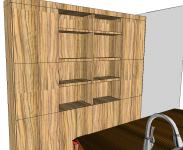I will be having an inspector out next week, but wanted to see what the thinking was here.
I have a rowhouse with brick walls, so I'm putting 3/4" x 2" plywood furring strips along one wall to give myself something to screw cabinets to and perhaps allow the electrician to run wire along. I'm also running 3/4" furring horizontally across the old fireplace to drywall over that. The fireplace itself is blocked w/ durock and capped at the chimney.
I'm also furring the short side of the fireplace and walling that up, so I can have a wall for a switchbox.
The furring on the wall for cabinets will end about 6" short of the ceiling. The other furring will also be slightly off the floor and ceiling (maybe 3" each end).
The existing ceiling is finished, and consists of drywall over plaster and lath.
In each of these cases, do I need to install perpendicular material of some kind to act as fireblocking? If i don't, is the inspector more likely to give me a rough time?
What about the exposed end of the cabinets, where I will cover up the gap to the wall with an end panel?
Thanks,
Adam
I have a rowhouse with brick walls, so I'm putting 3/4" x 2" plywood furring strips along one wall to give myself something to screw cabinets to and perhaps allow the electrician to run wire along. I'm also running 3/4" furring horizontally across the old fireplace to drywall over that. The fireplace itself is blocked w/ durock and capped at the chimney.
I'm also furring the short side of the fireplace and walling that up, so I can have a wall for a switchbox.
The furring on the wall for cabinets will end about 6" short of the ceiling. The other furring will also be slightly off the floor and ceiling (maybe 3" each end).
The existing ceiling is finished, and consists of drywall over plaster and lath.
In each of these cases, do I need to install perpendicular material of some kind to act as fireblocking? If i don't, is the inspector more likely to give me a rough time?
What about the exposed end of the cabinets, where I will cover up the gap to the wall with an end panel?
Thanks,
Adam

